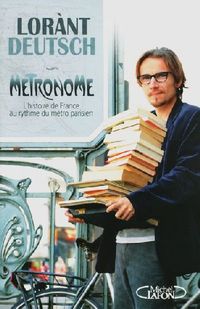Last year there was a run-away success in French publishing that didn’t fit into any of the usual categories. It was a history book organized around the Paris metro system called Metronome. The most improbable part was its author.
 Lorànt Deutsch is a 35-year-old actor, well known in France for many roles he has played in theater, film, and TV. It turns out he also has a well-established passion for history and a skill for writing.
Lorànt Deutsch is a 35-year-old actor, well known in France for many roles he has played in theater, film, and TV. It turns out he also has a well-established passion for history and a skill for writing.
Metronome consists of twenty chapters, each covering one century from the first to the twentieth (this is the idea of the metronome, ticking through history with uncompromising regularity). But the title also refers to the Paris public transportation system. For each century, Deutsch chose a metro station and combined his personal description of the station and its surroundings with the history of the century in question.
I have to say I had my doubts about how it was going to work – specifically, how he was going to keep our attention in centuries II through VIII or so. But he pulled it off. In fact, the approach provides a very nice balance and maintains the pace, allowing for spare treatment of each period without getting ensconced in any single one. One learns some very interesting things about little-known nooks of Paris’s history.
The chapter on the nineteenth century is organized around the République station. Deutsch starts with the statue of the female personification of the Republic that stands in the middle of the square, and circles back, telling the story of the area through the century until the era of the Third Republic that the statue represents. And, of course, he tells the story of this part of the the grands boulevards, immensely popular throughout the whole first half of the nineteenth century and then demolished by Haussmann’s administration around 1860. Deutsch ties it all together to give a succinct but nevertheless fairly complete window on nineteenth century Paris.
The resulting product is a lively and personal romp through Paris and through history. Deutsch brings a communicative enthusiasm to his subject, he does not shy away from expressing a strong personal perspective. He has a wonderfully lively voice, that of the impassioned layman rather than the crusty expert. It is a delightful read, and one that has opened the history of Paris to thousands of people who would never, ordinarily, open a history book.
I will nevertheless take this opportunity to mention a difference in view regarding the last chapter of the book. For the twenty-first century, Deutsch chose the neighborhood of La Défense and wrote a brief chapter lamenting what this soulless business district represents. Perhaps Deutsch is better with the past than with the future; certainly his voice is more compelling in the excitement of discovery than in hand-wringing about the direction of society. In any case, I believe Deutsch missed the true story of the twenty-first century: as the city intra-muros becomes gentrified and mummified, the real Paris is moving outside the périphérique; the Paris of the future is not in what we narrowly call Paris today at all – is in Montreuil, Aubervilliers, Pantin, Ivry, Saint-Ouen… This is a dynamic that is truly of the scale and nature of the developments that fascinate us in the other twenty marvelous chapters of Métronome.
Metronome came out toward the end of 2009 and, since then, has sold more than 500,000 copies. There is even an (unofficial) blog dedicated to the exploration of Paris through the eyes of the book: Les Paris DLD. I do not know if there are any English-language publication plans in the works, either in the UK or the US, but it seems to me that it could well be a success with the English-reading public as well.
